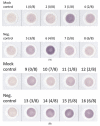Evaluation of Platelet Alloimmunization by Filtration Enzyme-Linked Immunosorbent Assay
- PMID: 37238189
- PMCID: PMC10217588
- DOI: 10.3390/diagnostics13101704
Evaluation of Platelet Alloimmunization by Filtration Enzyme-Linked Immunosorbent Assay
Abstract
The current methods for detecting antiplatelet antibodies are mostly manual and labor-intensive. A convenient and rapid detection method is required for effectively detecting alloimmunization during platelet transfusion. In our study, to detect antiplatelet antibodies, positive and negative sera of random-donor antiplatelet antibodies were collected after completing a routine solid-phase red cell adherence test (SPRCA). Platelet concentrates from our random volunteer donors were also prepared using the ZZAP method and then used in a faster, significantly less labor-intensive process, a filtration enzyme-linked immunosorbent assay (fELISA), for detecting antibodies against platelet surface antigens. All fELISA chromogen intensities were processed using ImageJ software. By dividing the final chromogen intensity of each test serum with the background chromogen intensity of whole platelets, the reactivity ratios of fELISA can be used to differentiate positive SPRCA sera from negative sera. A sensitivity of 93.9% and a specificity of 93.3% were obtained for 50 μL of sera using fELISA. The area under the ROC curve reached 0.96 when comparing fELISA with the SPRCA test. We have successfully developed a rapid fELISA method for detecting antiplatelet antibodies.
Keywords: antiplatelet antibody; fELISA; solid-phase red cell adherence test (SPRCA).
Conflict of interest statement
The authors declare no conflict of interest.
Figures





References
-
- Claas F.H., Smeenk R.J., Schmidt R., van Steenbrugge G.J., Eernisse J.G. Alloimmunization against the MHC antigens after platelet transfusions is due to contaminating leukocytes in the platelet suspension. Exp. Hematol. 1981;9:84–89. - PubMed
Grants and funding
LinkOut - more resources
Full Text Sources

